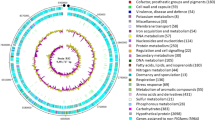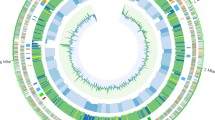Abstract
Strains originally affiliated to the genera Scopulariopsis and Microascus were compared regarding the scopularide production in order to investigate their ability to produce the cyclodepsipeptides and select the best suited candidate for subsequent optimisation processes. Phylogenetic calculations using available sequences of the genera Scopulariopsis and Microascus revealed that most of the sequences clustered within two closely related groups, comprising mainly Scopulariopsis/Microascus brevicaulis and Microascus sp., respectively. Interestingly, high yields of scopularide A were exhibited by three strains belonging to S./M. brevicaulis, while lower titres were observed for two strains of Microascus sp. Close phylogenetic distances within and between the two groups supported the proposed combination of both genera into one holomorph group. Short phylogenetic distances did not allow a clear affiliation at the species level on the basis of ribosomal DNA sequences, especially for Microascus sp. strains. Additionally, several sequences originating from strains assigned to Scopulariopsis exhibited a polyphyletic nature. The production pattern is in accordance with the phylogenetic position of the strains and significant production of scopularide B could only be observed for the S./M. brevicaulis strain LF580. Thus, the phylogenetic position marks the biotechnologically interesting strains and matters in optimisation strategies. In conclusion, the ability of all five strains to produce at least one of the scopularides suggests a distribution of the responsible gene cluster within the holomorph group. Setting the focus on the production of the cyclodepsipeptides, strain LF580 represents the best candidate for further strain and process optimisation.




Similar content being viewed by others
References
Abbott SP, Sigler L (2001) Heterothallism in the Microascaceae demonatrated by three species in the Scopulariopsis brevicaulis series. Mycologia 93:1211–1220
Abbott SP, Sigler L, Currah RS (1998) Microascus brevicaulis sp. nov., the teleomorph of Scopulariopsis brevicaulis, supports placement of Scopulariopsis with the Microascaceae. Mycologia 90:297–302
Barreiro C, Martin JF, Garcia-Estrada C (2012) Proteomics shows new faces for the old penicillin producer Penicillium chrysogenum. J Biomed Biotechnol 2012:105–109
Blunt JW, Munro MHG (2012) Dictionary of natural products on DVD. Chapman & Hall / CRC, Boca Raton
Bode HB, Bethe B, Höfs R, Zeeck A (2002) Big effects from small changes: possible ways to explore nature’s chemical diversity. Chembiochem 3:619–627
Dyková I, Pecková H, Kostka M (2008) Introduction of Mayorella gemmifera Schaeffer, 1926 into hylogenetic studies of Amoebozoa. Acta Protozool 47:205–210
Gomes NCM, Fagbola O, Costa R, Rumjanek NG, Buchner A, Mendona-Hagler L, Smalla K (2003) Dynamics of fungal communities in bulk and maize rhizosphere soil in the tropics. Appl Environ Microbiol 69:3758–3766
Harris SD, Turner G, Meyer V, Espeso EA, Specht T, Takeshita N, Helmstedt K (2009) Morphology and development in Aspergillus nidulans: a complex puzzle. Fungal Genet Biol 46:82–92
Hawksworth DL (2011) A new dawn for the naming of fungi: impacts of decisions made in Melbourne in July 2011 on the future publication and regulation of fungal names. IMA Fungus 2:155–162
Hawksworth DL (2012) Managing and coping with names of pleomorphic fungi in a period of transition. IMA Fungus 3:15–24
Hawksworth DL, Crous PW, Redhead SA, Reynolds DR, Samson RA et al (2011) The amsterdam declaration on fungal nomenclature. IMA Fungus 2:105–112
Hibbett DS, Binder M, Bischoff JF, Blackwell M, Cannon PF et al (2007) A higher-level phylogenetic classification of the Fungi. Mycol Res 111:509–547
Isaka M, Palasarn S, Kocharin K, Hywel-Jones NL (2007) Comparison of the bioactive secondary metabolites from the scale insect pathogens, anamorph Paecilomyces cinnamomeus, and teleomorph Torrubiella luteorostrata. J Antibiot (Tokyo) 60:577–581
Issakainen J, Jalava J, Hyvönen J, Sahlberg N, Pirne T, Campbell CK (2003) Relationships of Scopulariopsis based on LSUrDNA sequences. Med Mycol 41:31–42
Ito T, Masubuchi M (2014) Dereplication of microbial extracts and related analytical technologies. J Antibiot (Tokyo) 67:353–360
Kramer A, Paun L, Imhoff JF, Kempken F, Labes A (2014) Development and validation of a fast and optimized screening method for enhanced production of secondary metabolites using the marine Scopulariopsis brevicaulis strain LF580 producing anti-cancer active scopularide A and B. PLoS One. doi:10.1371/journal.pone.0103320
Kramer A, Beck HC, Kumar A, Kristensen LP, Imhoff JF, Labes A (2015) Proteomic analysis of anti-cancerous scopularide production by a marine Microascus brevicaulis strain and its UV mutant. PLoS One 10(10):e0140047
Krull R, Wucherpfennig T, Esfandabadi ME, Walisko R, Melzer G, Hempel DC, Kampen I, Kwade A, Wittmann C (2013) Characterization and control of fungal morphology for improved production performance in biotechnology. J Biotechnol 163:112–123
Kumar A, Henrissat B, Arvas M, Syed MF, Thieme N, Benz JP, Sørensen JL, Record E, Pöggeler S, Kempken F (2015) De novo assembly and genome analyses of the marine-derived Scopulariopsis brevicaulis strain LF580 unravels life-style traits and anticancerous scopularide biosynthetic gene cluster. PLoS One 10(10):e0140398
Lukassen MB, Saei W, Sondergaard TE, Tamminen A, Kumar A, Kempken F, Marilyn G, Wiebe MG, Sørensen JL (2015) Identification of the scopularide biosynthetic gene cluster in Scopulariopsis brevicaulis. Mar Drugs 13:4331–4343
McLaughlin DJ, Hibbett DS, Lutzoni F, Spatafora JW, Vilgalys R (2009) The search for the fungal tree of life. Trends Microbiol 17:488–497
Morton FJ, Smith G (1963) The genera Scopulariopsis bainier, Microascus zukal, and Doratomyces corda. Mycol Pap 86:1–96
Page RD (1996) TreeView: an application to display phylogenetic trees on personal computers. Comput Appl Biosci 12:357–358
Perriere G, Gouy M (1996) WWW-query: an on-line retrieval system for biological sequence banks. Biochimie 78:364–369
Pitt JI, Samson RA (2007) Nomenclatural considerations in naming species of Aspergillus and its teleomorphs. Stud Mycol 59:67–70
Pitt JI, Taylor JW (2014) Aspergillus, its sexual states and the new international code of nomenclature. Mycologia 106:1051–1062
Ropars J, Cruaud C, Lacoste S, Dupont J (2012) A taxonomic and ecological overview of cheese fungi. Int J Food Microbiol 155:199–210
Schoch CL, Seifert KA, Huhndorf S, Robert V, Spouge JL, Levesque CA, Chen W (2012) Nuclear ribosomal internal transcribed spacer (ITS) region as a universal DNA barcode marker for Fungi. Proc Natl Acad Sci U S A 109:6241–6246
Smedsgaard J, Frisved JC (1996) Using direct electrospray mass spectrometry in taxonomy and secondary metabolite profiling of crude fungal extracts. J Microbiol Methods 25:5–17
Tamminen A, Kramer A, Labes A, Wiebe MG (2014) Production of scopularide A in submerged culture with Scopulariopsis brevicaulis. Microb Cell Factories. doi:10.1186/1475-2859-13-89
Thompson JD, Gibson TJ, Plewniak F, Jeanmougin F, Higgins DG (1997) The CLUSTAL_X windows interface: flexible strategies for multiple sequence alignment aided by quality analysis tools. Nucleic Acids Res 25:4876–4882
Vainio EJ, Hantula J (2000) Direct analysis of wood-inhabiting fungi using denaturing gradient gel electrophoresis of amplified ribosomal DNA. Mycol Res 104:927–936
White TJ, Bruns T, Lee S, Taylor J (1990) Amplification and direct sequencing of fungal ribosomal RNA genes for phylogenetics. Chapter 38. In: Innis M, Gelfand D, Sninsky J, White T (eds) PCR protocols: a guide to methods and applications. Academic Press, Orlando, pp 315–322
Wickerham LJ (1951) Taxonomy of yeast. US Dept of Agriculture, USA
Yu ZG, Lang G, Kajahn I, Schmaljohann R, Imhoff JF (2008) Scopularides A and B, cyclodepsipeptides from a marine sponge-derived fungus, Scopulariopsis brevicaulis. J Nat Prod 71:1052–1054
Acknowledgments
The authors wish to thank Rolf Schmaljohann for microscopic analyses, and Jutta Wiese for the supply of preliminary obtained ITS1-5.8S rRNA-ITS2 and 18S rRNA gene sequences. Abhishek Kumar provided sequences from the complete genome data of LF580 for researching the ITS1-5.8S rRNA-ITS2 fragment. Arlette Wenzel-Storjohann performed DNA isolation and conducted PCR for sequences analysis.
We thank the Institute of Clinical Molecular Biology in Kiel for providing Sanger sequencing as support in part by the DFG Cluster of Excellence “Inflammation at Interfaces” and “Future Ocean”. We thank the technicians S. Greve, S. Arndt and T. Henke for technical support.
This study was performed in the framework of the MARINE FUNGI, EU FP7 KBBE program, project no. 265926.
Author information
Authors and Affiliations
Corresponding author
Ethics declarations
Conflict of Interest
The authors declare that they have no conflict of interest.
Electronic supplementary material
Below is the link to the electronic supplementary material.
ESM 1
(DOC 159 kb)
Rights and permissions
About this article
Cite this article
Kramer, A., Labes, A. & Imhoff, J.F. Phylogenetic Relationship and Secondary Metabolite Production of Marine Fungi Producing the Cyclodepsipeptides Scopularide A and B. Mar Biotechnol 18, 466–474 (2016). https://doi.org/10.1007/s10126-016-9707-7
Received:
Accepted:
Published:
Issue Date:
DOI: https://doi.org/10.1007/s10126-016-9707-7




